In my first blog post about the cryptic canid, it becomes perfectly obvious that for hundreds of years Black Shuck has been seen fairly frequently throughout all of East Anglia. Not only that, but he can still be seen there right up to the present day. Well known folklorist Ivan Bunn continues even now to find regular examples of Black Shuck’s appearances in our 21st-century world.
And so too, Black Shuck has been seen throughout the whole of the country. One website details 329 different places in the British Isles where spectral dogs of various size, shape, colour and attitude have cropped up over the centuries.
But has this famous dog ever been seen in our own county of Nottinghamshire? By careful searching on the Internet, I have managed to find just three examples. Read them through very carefully and make sure that you follow all the directions on the maps provided. There will be a test at the end!
The first tale is of a little village which now has the high-speed A631 dual carriageway constructed around it to the south west, allowing the peaceful, quiet community to preserve its rural tranquillity. Centuries ago, though, the main road from Sheffield to Gainsborough went right through the very middle of the village, which, with the frequent passage of mail coaches, it may well have been livelier than it is now….
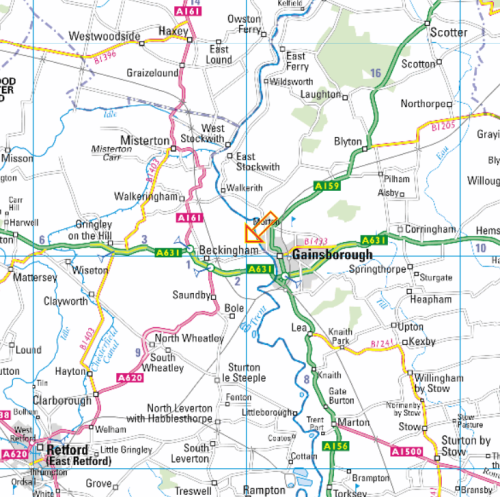
Perhaps this is why Beckingham’s most famous phantom, a colossal Black Dog, always keeps faithfully to his old tried and trusted route. The animal is reputed to be up to five feet tall and has dull red eyes that burn with an inner fire like the glowing embers on a coal fire
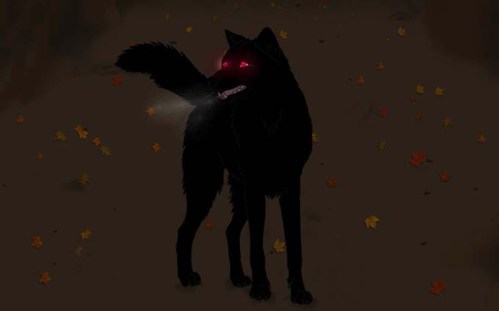 The Black Dog invariably leaves from the churchyard of Beckingham’s parish church of “All Saints” which dates mostly from the thirteenth century, although the exterior is apparently fifteenth century.
The Black Dog invariably leaves from the churchyard of Beckingham’s parish church of “All Saints” which dates mostly from the thirteenth century, although the exterior is apparently fifteenth century.

The Cryptic Canid leaves the little church with its square tower and makes his way, presumably down Walkeringham Road and then Station Street, before finally leaving the village along the Old Trent Road, walking purposefully out towards the marshy water meadows.
This map shows the church with its square tower and the red arrow points to the Old Trent Road.
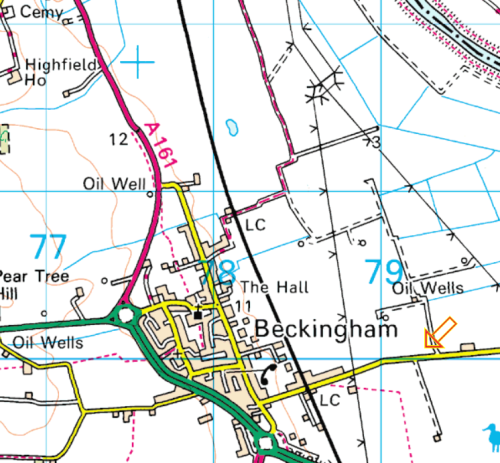
Some of the streets are indicated on this larger scale map. The red arrow points to the church…

The Black Dog always leaves the Old Trent Road (yellow on the map) near the Old Shipyard and then sets off along the old path to the south, alongside the old River Trent. The red arrow points to the riverside route he invariably uses.

Black Shuck though, for it is no less than he, is not a dog to mess with. Anybody who tries to get in his way or to prevent his progress from church to river does so very much at their own risk. A good many years ago a man from Gainsborough attempted to stop Black Shuck by refusing to stand aside and allegedly asking it what it was doing. The dog looked with great anger at this foolish person, who was later found unconscious in the middle of the road. He was paralysed down one side of his body for the rest of his life and never recovered the feelings in his arm or leg.
A second Black Shuck has occurred not too far from Newark-on-Trent. In the Nottingham County Library there is a manuscript dating back to as recently as 1952 which records the words of a Mrs Smalley, who was then about seventy five years old.
Her grandfather, who was born in 1804 and died in 1888, used to have occasion to drive from Southwell to Bathley, a village near North and South Muskham, in a pony and trap. This involved going along Crow Lane, which leaves South Muskham opposite the school and goes to Bathley. Along that lane he frequently, used to see a large Black Dog trotting alongside his trap.
Here is a map of South Muskham, with all the landmarks in the story visible.
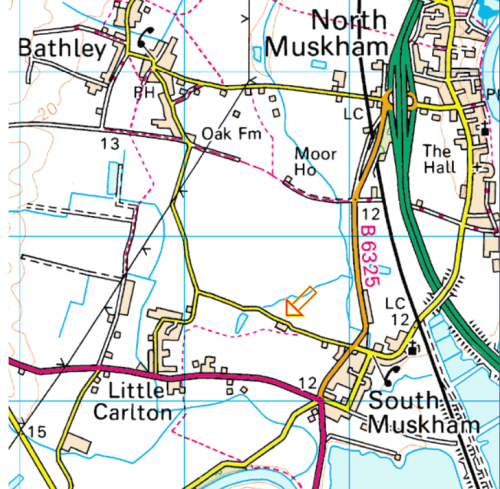 The red arrow points towards Crow Lane, which goes westward to Bathley. In the other direction, to the east, it runs, typically, past a church with a square tower.
The red arrow points towards Crow Lane, which goes westward to Bathley. In the other direction, to the east, it runs, typically, past a church with a square tower.
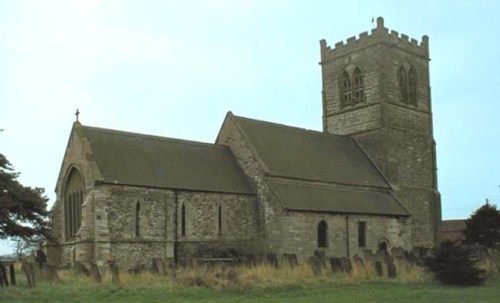
St. Wilfrid’s Church in South Muskham is medieval but seems to have taken a long time to construct. The square tower, therefore, has its lowest section of thirteenth century construction, the middle section is fourteenth century and the top is fifteenth century. One of the more interesting features are the carved ends of the wooden benches in the chancel, which include a number of “hideous monsters” and one crab.
“Round about 1915, Mrs Smalley’s son Sidney, used to ride out from Newark on a motorcycle to their home at Bathley. He went into Newark to dances and frequently returned at about 11 o’clock at night. He too often saw a black dog in Crow Lane; he sometimes tried to run over it but was never able to. One night Sidney took his father on the back of the motorcycle especially to see the dog, and both of them saw it.”
Overall, South Muskham is an area with a good deal of water in the landscape.
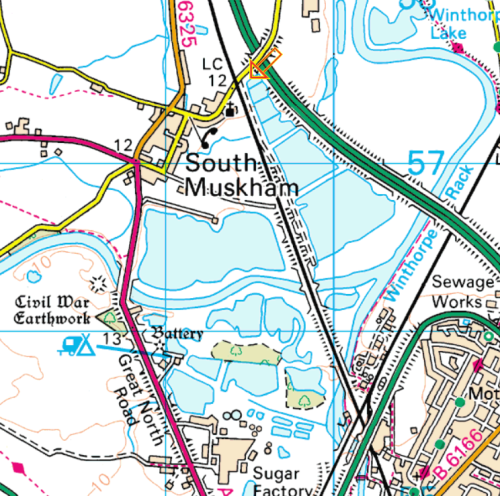
The third story is considerably more modern. It was 2.14 a.m. on May 11th 1991 and….
“Victoria Rice-Heaps had been visiting her boyfriend in Worksop, and was on her way home when she had her unusual experience. It was a journey she had made “thousands of times”. She wasn’t particularly tired, having slept earlier in the evening. Making her way out along the Blythe Road, she soon left the comforting glow of the streetlights for the dark country roads beyond.
After a mile or so, near to Hodsock Priory, Victoria saw illuminated in the beam of her headlights about 150 yards ahead “two red dots.”

“I slowed right down to a crawl as I saw a huge black dog. It looks like something from hell! It had very shiny fur and a short coat; the nearest thing I’ve seen to it in size was a Great Dane, but it had a good 18 inches over a dog of that breed. Its ears were erect and it appeared to be dragging something quite large across the road.”
Victoria had lived with dogs all her life, but had seen nothing like this creature.
As she waited for the dog to get out of the way of her Fiat Panda, the headlights of another vehicle announced its approach from the opposite direction. The driver of the red Montego estate, evidently seeing her at a standstill, pulled up and wound down his window to ask if anything was wrong. Victoria, having wound down her own window, asked the man if he could see the dog in front of her car.
“At this moment he shouted “Oh Jesus!” and sped off into the night. I looked in front of me again and to my joy and amazement the creature had vanished. I drove home as fast as I could. I did a little research later and found a tumulus nearby, a river and an old boundary as well as the priory”.
There is a lot less exact geographical detail for this particular story and I have therefore made one or two “best guesses”.
Victoria was driving north out of Worksop along the B6045 in the direction of Blyth. This road is fairly straight and leads quickly to the Hodsock area. The very narrow yellow road to the west of the B6045 is the turn off to Hodsock Priory, which is a big country house, rather than anything of particularly religious significance. In Nottinghamshire, it is very famous for its magnificent displays of snowdrops in the very first days of Spring.

My contention, though, is that Victoria only saw a single snapshot moment of Black Shuck’s usual journey. I believe that the huge dog would have started his journey in the northern section of the B6045. Here is a map with the middle of Blyth and the old unnamed northern section of the B6045 (see arrow). It leads past a church with the square tower, St Mary and St Martin.
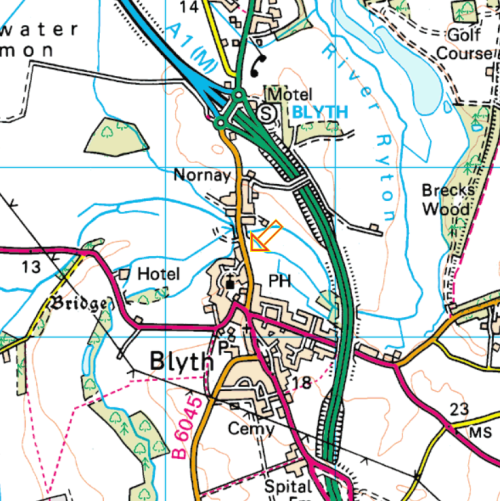
Shuck’s exact point of departure would surely have been the churchyard of this ancient church which dates from as early as 1088, when it was a part of a Benedictine monastery. Clearly, if you are driving down the B6045 in a saloon car at 40-50 m.p.h. in the darkness of the night, you will see Black Shuck for a lot less time than if you are on foot, or in a pony and trap, or even on a slow motorbike back in 1915.
The one thing I would really like to know, though, is what “quite large something” Black Shuck was dragging across the road. And the driver of the red Montego, how had he not seen the ghostly dog when he first stopped? He was going in the opposite direction to Victoria, and Black Shuck was right in front of her car. The driver of the red Montego must have been parked almost directly next to the “Hound from Hell”. Indeed, she actually asked him if he could see the dog in front of her car.
When he apparently and finally saw this enormous beast, he shouted out in terror and drove off into the night. Why? He left a defenceless young woman behind on her own. Did he see what Black Shuck was dragging? Given the Hell Hound’s connection with the imminent death of those who see it, did the man see his own ghostly corpse?
If you have followed the directions and maps carefully, you will not find my next question a particularly difficult one!
“What is the connection between all three of the Black Dogs seen in Nottinghamshire?”
Well, if you have paid attention, you will have realised the elements which occur and recur throughout all three stories.
There is always a church, and the Ordnance Survey map shows that it is always a church with a square tower. That church of course, will have a graveyard around it. Black Shuck then follows a route which is always a very ancient one, rather than opting for the new bypass or the new dual carriageway. It is always a road which has been there for centuries, almost as if he has been following that path for that same amount of time. And as the road continues away from the church, it will gradually become more and more lonely and isolated. At the same time it will lead through a landscape which contains enormous amounts of water, either in the form of lakes, rivers or streams. In one case, namely that of Beckingham, the road leads to the wettest place of all. This is an area of riverside water meadows, which have now been taken by the RSPB to form an official wetland nature reserve.
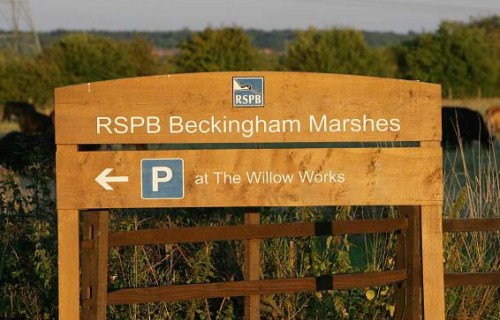
Black Shuck makes his departure from this route not only at an old shipyard, but he also sets off southwards alongside the River Trent itself. As if to prove that this is the strongest manifestation of Black Shuck in the county, the phantom animal will pass an ancient hill which is called “Black Island”. This may have been a tumulus in the dim and distant past. Somewhere as flat and wet as this area is certainly a strange place for a completely natural hill.
Victoria Rice-Heaps mentions a tumulus near the B6045, but I have been unable to trace it, although I have not visited the area personally. This does not mean that it is not there, of course. But there is a “Hodsock Red Bridge”, red with the colour of Black Shuck’s eyes, perhaps? And what is “Black Screed”? Nowadays, a screed is “a levelled layer of material (e.g. cement) applied to a floor or other surface.” Earlier than this, it was “a fragment cut from a main piece”, and then “a torn strip”. Was it called “Black Screed” because it was connected with Black Shuck and being “torn to shreds”?
I was delighted to find all these various connections, because they fit in perfectly with the book “Real Wolfmen: True Encounters in Modern America” by Linda S Godfrey. She provides a key quotation about the appearance of spectral canids. And this quotation applies not only to North East Nottinghamshire, but also to the state of Wisconsin in the north eastern part of the United States.
I will be looking at all these various connections and trying to explain why they are so important in another blog post in the future.

































